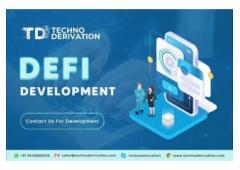Description
Introduction: Decentralized Finance (DeFi) is reshaping the traditional financial landscape by leveraging blockchain technology to create an open, transparent, and accessible financial ecosystem. This article explores the principles, innovations, and potential impact of DeFi, highlighting its transformative journey in empowering individuals and revolutionizing the way we think about and engage with financial services.
Understanding Decentralized Finance (DeFi): DeFi represents a paradigm shift in the financial sector, moving away from centralized intermediaries such as banks and brokers. Built on blockchain networks, DeFi aims to provide permissionless and trustless financial services, allowing users to transact, lend, borrow, and invest without relying on traditional institutions.
Key Components of DeFi: Smart contracts, self-executing contracts with predefined rules, are the backbone of DeFi. These contracts automate financial processes, enabling seamless and secure transactions. Decentralized exchanges (DEXs), lending protocols, and liquidity pools are essential components that facilitate a wide range of financial activities within the DeFi ecosystem.
Lending and Borrowing Protocols: DeFi lending platforms allow users to lend or borrow assets directly from one another, eliminating the need for intermediaries. Through smart contracts, users can lock collateral to secure loans or earn interest by providing liquidity to lending pools, creating a decentralized and efficient lending market.
Decentralized Exchanges (DEXs): Decentralized exchanges enable users to trade digital assets directly from their wallets without relying on a centralized authority. By leveraging smart contracts and liquidity pools, DEXs provide a transparent and secure environment for peer-to-peer trading, reducing counterparty risk.
Asset Management and Yield Farming: DeFi introduces innovative ways for users to optimize their assets through yield farming and liquidity provision. By staking assets in decentralized protocols, users can earn rewards, often in the form of additional tokens, creating opportunities for passive income and asset growth.
Challenges and Risks: While DeFi offers promising opportunities, it also faces challenges such as security vulnerabilities, smart contract exploits, and regulatory uncertainties. Users and developers must navigate these risks while the industry continues to evolve and mature.
Regulatory Landscape and Compliance: DeFi operates in a rapidly evolving regulatory environment. As governments around the world grapple with the implications of decentralized finance, finding a balance between innovation and regulatory compliance remains a challenge. DeFi projects are increasingly focusing on incorporating measures for Anti-Money Laundering (AML) and Know Your Customer (KYC) compliance.
The Future of Decentralized Finance: The future of DeFi holds immense potential for financial inclusion. As the technology matures and scalability issues are addressed, DeFi has the opportunity to provide financial services to the unbanked, enable more efficient cross-border transactions, and democratize access to a wide range of financial instruments.
Conclusion: Decentralized Finance is more than a technological advancement; it represents a fundamental shift in the way financial services are conceptualized and accessed. By embracing the principles of transparency, openness, and inclusivity, DeFi has the potential to redefine global finance, empower individuals, and create a more equitable and accessible financial ecosystem for people around the world. As the DeFi space continues to evolve, its impact on traditional finance and the broader economy is poised to be transformative.













